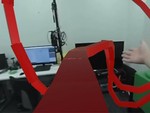VR
Projects

Groovy Walking
We proposed and evaluated a system that aims to reduce VR sickness by using rhythmic head movements as walking input in a VR …
Projects

A virtual tennis training support system using simple visual feedback
We developed a method for VR tennis training that briefly displays the racket’s position and orientation as a ghost. By providing …
Projects

VR-iai
When swinging a sword in VR space, displaying the sword movement at the user’s actual operation speed makes it feel slow and …
Projects

Investigation of Appropriate Nodding Frequency According to Audience Size
In a VR virtual audience system using a speech-driven nodding generation model, we found that applying the nodding frequency adjusted …
Projects

Ghostgram
"Ghostgram" is a new technology that greatly advances the techniques our laboratory has provided for the "3D Noh" …
Projects

Pose Input Support System for 3D Avatars Using Simple Motion Capture Devices
When operating 3DCG avatars with VR equipment, it is difficult to input poses suitable for avatars with different appearances from …
Projects

Immersive Class Video System to Facilitate Learners' Conformity through Interactive Lectures
In online lectures, learners tend to be passive and struggle to maintain learning motivation. In this research, we developed a VR …
Projects

VR Rakugo
The virtual rakugo theater system uses VR technology to enable even beginners to experience speaking rakugo in a karaoke-like manner. …
Projects

VR System for Experiencing Historical Presentations with Virtual Audiences
A VR system that allows users to relive famous historical speeches and presentations as if they were the speakers themselves. Users can …
Projects

VR System Presenting the Traveling Direction in 360-degree Live-action Video
A VR system that records camera movement paths during shooting using the VIVE tracking system and presents them as rails in VR space, …
